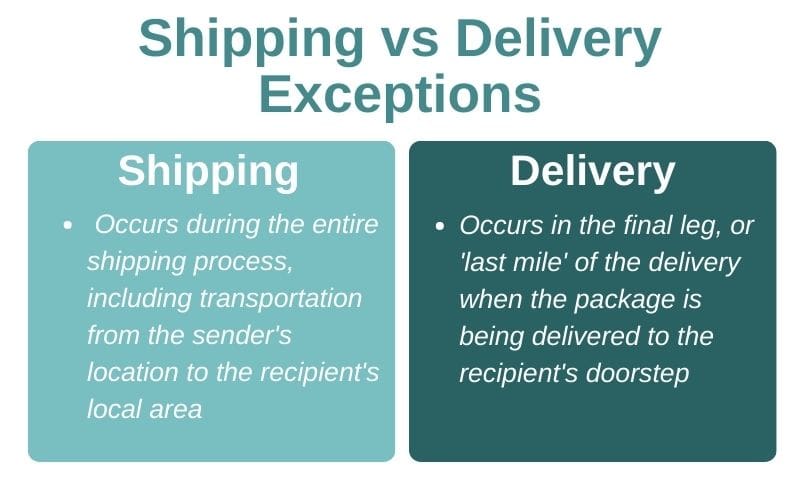
Simple Steps to Understand, Prevent & Fix Them
Delivering packages to customers on time is a top priority in the fast-paced world of logistics and eCommerce. Despite the meticulous planning and execution of today’s businesses, unforeseen challenges can arise during the shipping process, leading to what is known as a “shipment exception.” Understanding what shipment exceptions are and how to effectively handle them is crucial for businesses and customers alike.
In this comprehensive guide, we’ll take a closer look at shipment exceptions: what they are, how they differ from delivery exceptions, and the common factors that can lead to them. We’ll also explore the impacts of shipment exceptions on customer experience and the broader supply chain. Finally, we’ll shed light on the importance of addressing these challenges promptly.
Whether you’re a customer eagerly awaiting a package or a business navigating the complexities of last-mile delivery, knowing how to respond to shipment exceptions is important. We’ll provide practical insights for both customers and businesses, outlining the best approaches for communication, expectation management, and rapid adaptation to ensure a smooth resolution.
What Does Shipment Exception Mean?
A shipment exception refers to a temporary delay or disruption that occurs during the transportation of a package or cargo from the sender to the recipient. These exceptions can arise due to unforeseen circumstances or issues encountered while the shipment is in transit, affecting its scheduled delivery.
Shipment Exceptions vs Delivery Exceptions

While the terms “shipment exception” and “delivery exception” are often used interchangeably, there’s a subtle difference between the two. A shipment exception generally pertains to issues occurring during the entire shipping process, including transportation from the sender’s location to the recipient’s local area. On the other hand, a delivery exception typically occurs during the final leg of the journey, often referred to as the “last mile,” when the package is delivered to the recipient’s doorstep.
Common Causes of Shipment Exceptions
Shipment exceptions can be triggered by a variety of factors, ranging from external influences like weather conditions, customs delays during international shipping, and regulatory holdups to internal issues such as damaged shipping labels or missing documentation. Any unexpected event that hinders the smooth transportation of the package can result in a shipment exception.
Understanding the distinction between shipment exceptions and delivery exceptions helps businesses and consumers identify the specific stage at which a disruption occurred in the shipping process. By recognizing the causes of these exceptions, companies can take proactive measures to prevent or minimize their impact, ensuring a more reliable and efficient shipping experience for all parties involved.
Impacts of Shipment Exceptions
Impact on the Customer Experience
Shipment exceptions can significantly impact customer experience, leading to frustration and disappointment. When packages are delayed or encounter unexpected issues, customers can form the opinion that the brand or retailer is unreliable or untrustworthy. The lack of timely delivery can also result in heightened anxiety and inconvenience for recipients who were eagerly awaiting their orders. In such cases, Customers will reach out to customer support for answers and explanations, increasing the workload of the support team which further affects the overall customer experience.
Impact on the Rest of the Supply Chain and Delivery
Shipment exceptions can cause a ripple effect throughout the supply chain and delivery process. When a shipment encounters an exception, it may disrupt the planned logistics and transportation schedule. As a result, other packages in the same shipment batch or route might also experience delays. Shipment exceptions can cause problems in the shipping process, leading to inefficiencies, extra expenses, and difficulties in managing the movement of goods.
If the exception isn’t promptly addressed and resolved, it can lead to inventory discrepancies, potentially affecting stock levels and availability for future orders. In some cases, to make matters even worse, shipment exceptions can result in returned packages, which generates more work in additional handling and logistics efforts.
For businesses relying on third-party logistics providers (3PLs) or carriers, shipment exceptions can put a strain on relationships and accountability. The 3PL or carrier’s handling of exceptions and their responsiveness to resolving issues can directly impact the brand’s reputation and customer satisfaction.
Keeping the occurrence of shipment exceptions to a minimum, and efficiently managing them when they do happen, is crucial for delivering a positive customer experience while maintaining a smooth supply chain and delivery process. Companies that proactively address shipment exceptions and communicate transparently with their customers can mitigate negative impacts and strengthen their brand’s reliability.

Prevention of Shipment Exceptions
Preventing shipment exceptions demands a proactive and vigilant approach, where businesses pay close attention to multiple facets of the shipping process. From accurate address verification to timely communication with customers, implementing robust systems and strategies can significantly reduce the likelihood of encountering shipment exceptions. By identifying potential roadblocks beforehand and swiftly addressing any issues that may arise, businesses can ensure smoother logistics operations, lower costs, and ultimately deliver a more satisfying experience to their valued customers.
Here are key strategies to minimize the occurrence of shipment exceptions:

- Accurate Address Verification: Ensure accurate address entry by customers during the checkout process. Implement address validation tools to catch and correct any inaccuracies, incomplete details, or undeliverable addresses. Properly formatted addresses reduce the risk of shipment exceptions due to address-related issues.
- Weather Monitoring and Contingency Planning: Stay informed about weather conditions along shipping routes to anticipate potential delays caused by inclement weather or natural disasters. Implement contingency plans to reroute shipments or adjust delivery schedules when adverse weather conditions are forecasted.
- Robust Packaging and Labeling: Use sturdy and weather-resistant packaging materials to protect shipments from damage during transit. Ensure shipping labels are clear, legible, and securely attached to packages to avoid scanning or address-related exceptions.
- Carrier Diversification: Work with multiple reliable carriers to reduce dependency on a single provider. Diversifying carriers can help maintain shipping efficiency during peak seasons or if one carrier experiences disruptions.
- Real-Time Shipment Tracking: Offer customers real-time tracking information and notifications about their shipments. Transparent and proactive communication keeps customers informed and minimizes inquiries about delivery status, reducing the likelihood of customer frustration.
- International Shipping Preparedness: For international shipments, ensure all necessary customs documentation is complete and accurate. Partner with carriers experienced in international shipping to navigate customs regulations and avoid unnecessary delays.
- Customer Communication: Be proactive in communicating with customers about potential delays caused by shipment exceptions. Notify them as soon as possible, provide clear explanations, and offer solutions or alternatives to manage expectations.
- Collaboration with 3PL Partners: If using third-party logistics providers, maintain open lines of communication and collaborate closely with them. Share shipment information promptly and work together to address exceptions swiftly.
- Continuous Improvement: Regularly review shipping data and analyze past shipment exceptions to identify recurring patterns or issues. Update your processes and improvements accordingly based on these insights to reduce future exceptions.
By putting preventive measures in place, businesses can enhance their shipping operations, reduce shipment exceptions, and deliver a more reliable and satisfying experience for their customers. Proactive planning and responsive customer support are invaluable in maintaining a smooth supply chain and building positive customer relationships.
Resolving Exceptions: What to Do When an Exception Occurs
As a Customer:
Encountering a shipment exception as a customer can be frustrating. But there are proactive steps you can take to address the situation and get your package’s delivery back on track. Here’s what to do when you come across a shipment exception:
- Contact the Supplier or Retailer: The first step is to reach out to the supplier or retailer from whom you made the purchase. Most reputable suppliers have a dedicated customer support team that can assist you with shipment inquiries. Provide them with your order details and tracking number to help them quickly identify the exception and its cause.
- Get an Updated ETA: Ask the supplier for an updated estimated time of arrival (ETA) for your package. They may have received additional information from the carrier regarding the exception, which could provide insight into when you can expect your delivery.
- Clarify Address Information: If the exception was due to an address-related issue, verify and clarify your shipping address with the supplier. Make sure that all details, including the recipient’s name, street address, apartment or suite number (if applicable), city, state, zip code, and country, are accurate and complete.
- Follow Carrier Instructions: If the carrier has left specific instructions for you, such as rescheduling a delivery or picking up the package from a nearby location, make sure to follow those instructions promptly to avoid further delays.
- Be Patient and Understanding: Shipment exceptions are often beyond the supplier’s control and can be caused by factors like weather, unforeseen events, or carrier-related issues. While it’s understandable to be eager to receive your package, exercising patience and understanding during these exceptional circumstances can help facilitate a smoother resolution.
- Keep Communication Lines Open: Maintain communication with the supplier and stay updated on the status of your shipment. Inquire about any progress made in resolving the exception and request timely updates.
As a Business:
When a shipment exception occurs, businesses must respond promptly and transparently to ensure customer satisfaction and maintain smooth operations. Here’s what businesses can do when faced with a shipment exception:

- Customer Communication: Notify the customer proactively about the exception via email or text (SMS). Be transparent about the issue and provide an updated ETA for their delivery. Keep them informed about any progress in resolving the exception. **customer communication graphic
- Customer Support: Ensure your customer support team is well-informed about the exception and can provide accurate information to concerned customers. Promptly respond to customer inquiries and offer solutions to address their concerns.
- Address Verification: If the exception was caused by an incorrect address, establish a robust address verification process to minimize address-related exceptions in the future. Implement automatic address validation tools to catch potential errors before shipments go out.
- Real-Time Updates and Automation: Utilize last-mile technology that offers real-time updates on shipment status and automated route building. This empowers both customers and your team with up-to-date information, allowing for quick adaptation to any changes and avoiding disruptions to operations.
- Supply Chain Resilience: Diversify your carrier network and shipping options to build resilience in your supply chain. Partner with carriers known for reliable service and contingency plans in case of exceptions.
- Offering Solutions: Be proactive in offering solutions to customers affected by the exception. Depending on the circumstances, consider offering discounts, expedited shipping, or other forms of compensation to maintain customer satisfaction.
- Learn from Exceptions: Conduct regular reviews of shipment exceptions to identify patterns or recurring issues. Use this data to make informed decisions about carrier selection, and shipping methods, and address potential problem areas in your supply chain.
By promptly addressing shipment exceptions and maintaining transparency with customers, businesses can effectively manage customer expectations, prevent potential negative impacts on their brand reputation, and ensure smooth operations even during extraordinary situations. Leveraging last-mile technology and continuously improving processes will help businesses stay agile and deliver exceptional customer experiences.
Final Thoughts
Shipment exceptions are an inevitable part of the shipping process, affecting both customers and businesses alike. While they can be frustrating, being prepared and responsive in such situations can make all the difference in resolving the issue and ensuring a positive customer experience.
As a customer, promptly contacting the supplier, verifying address details, and staying patient can help expedite the resolution of shipment exceptions. On the business side, effective customer communication, robust address verification processes, and leveraging last-mile technology for real-time updates are crucial in managing exceptions and maintaining smooth operations.
At Elite EXTRA, we understand the challenges that come with last-mile delivery and handling shipment exceptions. Our advanced last-mile delivery management software empowers businesses with real-time tracking, automated route building, and proactive customer communication to tackle exceptions with ease. With Elite EXTRA’s innovative solutions, you can ensure exceptional delivery experiences for your customers while optimizing your supply chain operations.
Don’t let shipment exceptions slow you down. Enhance your delivery performance and customer satisfaction with Elite EXTRA. Contact us today to learn more about how our delivery management software can transform your business.
Sources
https://www.fedex.com/en-us/customer-support/faqs/receiving/delivery-exception.html
https://patch.com/us/across-america/package-delivery-mistakes-be-neighborly-exceptions-block-talk







